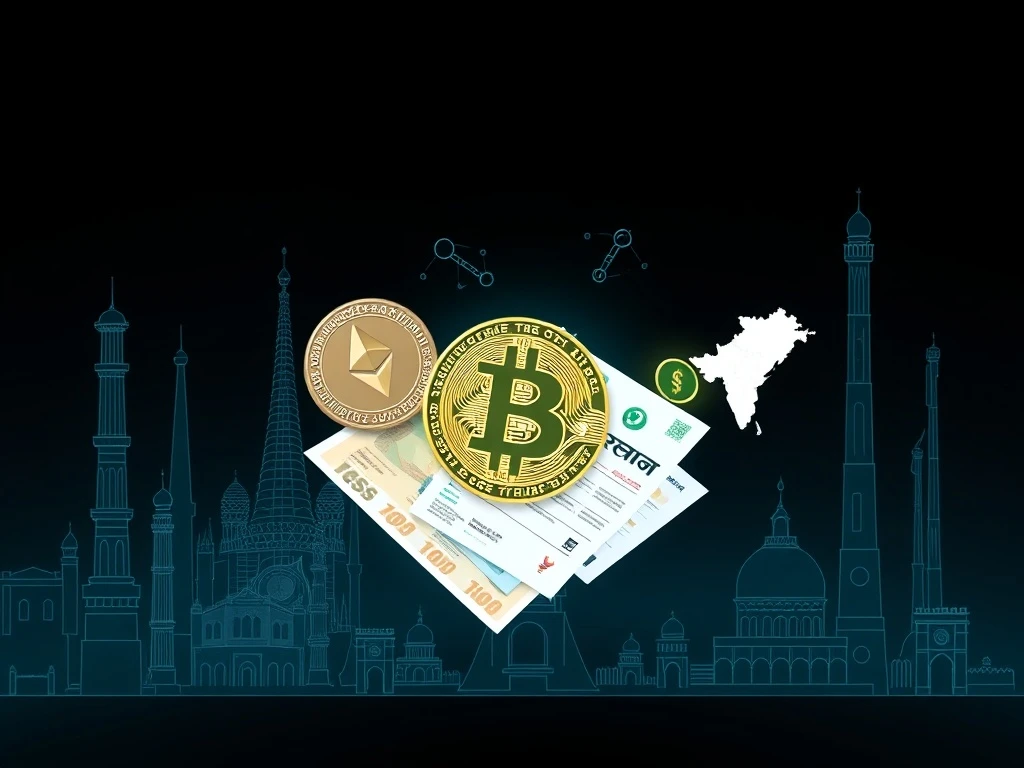Crypto Tax India: Essential 2025 Guide for Traders to Navigate Complex Regulations

Are you actively trading or investing in cryptocurrencies within India? Understanding the evolving tax landscape is absolutely crucial. India’s approach to digital assets continues to mature, bringing specific obligations for every trader. This comprehensive guide simplifies the **Crypto Tax India** rules for 2025. It equips you with the knowledge needed to ensure full compliance and avoid potential penalties. Navigating these regulations can seem daunting, but clarity is within reach.
Understanding India Crypto Tax Rules in 2025
For the financial year 2024-2025, Indian tax law classifies cryptocurrencies as Virtual Digital Assets (VDAs). The Income Tax Act, 1961, specifically Section 2(47A), outlines this definition. Any code, number, token, or piece of information created through cryptography qualifies as a VDA. This broad definition includes popular cryptocurrencies like Bitcoin (BTC) and Ether (ETH). It also encompasses non-fungible tokens (NFTs) and similar digital tokens. Significantly, fiat currencies, whether Indian rupees or foreign currency, are the only exceptions. While legal to buy, sell, and hold VDAs, they do not function as valid payment methods in India. Consequently, crypto operates in a legally distinct space in India for 2025. It is permitted, but authorities closely monitor it for taxation and anti-money laundering (AML) purposes.
Several agencies oversee crypto transactions in India. The Income Tax Department enforces tax compliance. It receives guidance from the Central Board of Direct Taxes (CBDT) under the Ministry of Finance. The CBDT establishes key tax policies. Furthermore, the Financial Intelligence Unit (FIU-IND) ensures platforms adhere to AML standards. Meanwhile, the Reserve Bank of India (RBI) and the Securities and Exchange Board of India (SEBI) shape broader regulatory policies. These bodies collaborate to oversee crypto taxation nationwide. A significant legislative update occurred on August 22, 2025. On this date, the Income Tax (No. 2) Bill, 2025, received presidential assent. This bill effectively replaced the previous Income Tax Act, 1961, bringing updated provisions into force.
Key Taxable Events for Crypto Traders in India
India subjects crypto transactions to a specific tax framework. This includes a flat 30% tax on gains from transfers. Additionally, a 1% Tax Deducted at Source (TDS) applies to all transfers, regardless of profitability. Therefore, a taxable event in crypto signifies any activity that generates a tax liability under Indian law. This includes transactions that produce income, gains, or measurable benefits in fiat money. For any trader or investor, understanding what constitutes a taxable event is paramount. It is key to staying compliant with the Income Tax Act. Identifying these events early helps prevent future complications.
Key taxable events include:
-
Trading: Exchanging crypto for another crypto, or for fiat currency, is a taxable event. For example, selling BTC for INR or swapping ETH for SOL incurs tax.
-
Staking Rewards: When you receive staking rewards, they count as income. The moment tokens are credited to your wallet, they become taxable.
-
Airdrops and Hard Forks: Tokens received from airdrops or hard forks are treated as income. This applies once the tokens appear in your account.
-
Mining Income: Income generated from crypto mining is taxed as business income. Subsequent sales of these mined assets are then subject to capital gains tax.
-
Payments in Crypto: Using crypto to pay for goods or services is considered taxable business or professional income. The fair market value at the time of payment determines the taxable amount.
Conversely, some actions do not trigger tax liability. Non-taxable events typically include holding digital assets without selling them. Transferring crypto between your personal wallets also falls into this category. These actions do not produce immediate income or gains, so they are not subject to tax at that specific point. Did you know? Indian law offers no tax relief if you lose your crypto due to theft or hacks. Non-compliance, however, can attract severe penalties, interest, and prosecution for willful evasion. This emphasizes the importance of secure asset management and diligent record-keeping.
Decoding VDA Tax India: Rates and Classifications
In India, income derived from cryptocurrencies primarily falls into two categories: business income or capital gains. If your trading activities are regular, systematic, and constitute a primary source of income, authorities will tax your earnings as business income. This income then falls under standard income tax slabs. However, for most individual investors, profits from buying and selling cryptocurrencies are considered capital gains. This distinction is crucial for proper tax filing. As of August 22, 2025, a flat 30% rate applies to both short-term capital gains (STCG) and long-term capital gains (LTCG) on VDAs under Section 115BBH. This rule remains consistent regardless of how long you hold the assets. The government permits no deductions, except for the cost of acquisition. Importantly, you cannot offset losses from one VDA against gains from another. Furthermore, you cannot carry forward VDA losses to future financial years. This specific provision makes VDA taxation quite rigid compared to traditional asset classes.
Business income from crypto is technically taxed at slab rates. However, it often faces a similar effective tax burden. This is largely due to the flat 30% rate applied to VDA transfers. Additionally, a 1% TDS is mandated for all crypto transfers exceeding a certain threshold. This measure aims to enhance transparency and ensure compliance across all platforms. It includes trades conducted on centralized exchanges. It also covers peer-to-peer (P2P) transactions. This broad application of TDS helps authorities monitor the expanding crypto market more effectively. Therefore, understanding both the 30% flat tax and the 1% TDS is vital for every crypto participant in India.
Mastering Crypto TDS India: Section 194S Explained
India’s tax framework for cryptocurrencies notably includes a 1% TDS under Section 194S. This mandatory deduction applies to most VDA transactions. It was introduced to significantly improve compliance and monitor the rapidly expanding crypto market. Understanding its mechanics is essential for both buyers and sellers. The main aspects of **Crypto TDS India** are detailed below:
-
TDS Mechanism: When you purchase a VDA, the buyer must deduct a fixed percentage of the sale amount as TDS. They then deposit this amount with the government. This deducted sum represents the tax withheld from the seller’s payment. It ensures that a portion of the tax is collected at the source of the transaction.
-
TDS Rate and Threshold: Section 194S imposes a 1% TDS on the sale amount. This applies if transactions exceed 50,000 Indian rupees in a financial year. However, for certain specified persons, this threshold is lowered to 10,000 rupees. It helps capture a wider range of transactions.
-
TDS for Non-Cash Transactions: If a buyer acquires a VDA using another VDA (a non-cash payment), they still must deduct 1% TDS. This deduction must be in cash, based on the VDA’s sale value. The buyer then submits this cash amount to the government.
-
Mixed Payment Scenarios: Sometimes, a buyer pays for a VDA with a combination of cash and non-cash assets. If the cash portion is insufficient to cover the 1% TDS, the buyer must pay the additional TDS amount from their own funds. This ensures the full TDS liability is met.
-
No TAN Requirement for Specified Persons: Under Section 203A, a “specified person” (as defined under the law) does not need to obtain a Tax Deduction and Collection Account Number (TAN) for TDS purposes. This simplifies compliance for certain entities.
-
TDS Exemption for Specified Persons: No TDS is deducted for a specified person if the total VDA consideration in a financial year is 50,000 rupees or less. This provides a small relief for lower-value transactions.
-
TDS Exemption for Non-Specified Persons: For individuals other than specified persons, no TDS is deducted if the VDA consideration is 10,000 rupees or less in a financial year. This threshold caters to smaller retail investors.
-
Precedence over E-commerce Rules: If a VDA transaction falls under both Section 194S and Section 194-O (related to e-commerce operators), the provisions of Section 194S take priority. This clarifies which rule applies in overlapping situations.
-
TDS on Suspense or Temporary Accounts: If the buyer deposits the VDA payment into a suspense or temporary account of the seller, the seller becomes responsible for deducting the TDS. This prevents evasion through intermediate accounts.
Did you know? Using foreign exchanges does not exempt traders’ profits from offshore platforms. They must declare all their transactions in Indian Income Tax Returns (ITRs). This may also trigger scrutiny under the Foreign Exchange Management Act, 1999 (FEMA).
Calculating Your Crypto Tax India Liability
To accurately calculate your **Crypto Tax India** liability, you must first determine the cost basis. The cost basis represents the purchase price of the VDA. It also includes related expenses like exchange or transaction fees. This figure forms the foundation for calculating gains or losses when you sell or transfer the asset. Traders can employ various methods to track their transactions. These include first-in-first-out (FIFO), last-in-first-out (LIFO), or specific identification. The choice of method often depends on the accuracy and detail of your records. Importantly, you must use the chosen method consistently across all your filings. In crypto-to-crypto trades, the transaction is effectively treated as two separate events. You sell one asset, which triggers gains or losses, and then you buy another. Both assets are valued at their fair market price in rupees at the time of the trade. This dual transaction approach can complicate calculations.
Certain expenses are permissible for inclusion in the cost of acquisition. These typically include transaction fees, wallet or exchange charges, and even crypto tax software costs. These directly relate to acquiring the asset. However, Indian law does not permit broader deductions beyond these specific acquisition costs. For instance, you cannot deduct operational expenses or losses from other income sources. This strict limitation on deductions means that the 30% tax rate applies to a relatively high base. Traders must meticulously track all relevant costs. Maintaining clear records of purchase prices, transaction dates, and associated fees is paramount. This diligence helps ensure accurate tax calculations and compliance. Any discrepancy can lead to complications during tax assessments.
Navigating Indian Crypto Regulations: Reporting and Compliance
Indian tax law mandates reporting all crypto transactions. There are no exceptions, even for losses. You must declare income under the VDAs category. Typically, ITR-2 covers capital gains from VDAs. If your crypto activities constitute a business, ITR-3 applies. From the financial year 2025-26, a new Schedule VDA will be introduced. This schedule will require taxpayers to report each crypto transaction separately. This change aims to provide greater transparency and detail to the tax authorities. Taxpayers must therefore maintain accurate records. These records should include transaction details, exchange statements, wallet addresses, and rupee valuations. Such documentation is vital, particularly during audits or scrutiny by the tax department.
For individuals not requiring an audit, the deadline for filing income tax returns in 2025 is July 31, 2025. Businesses that require an audit must file by October 31, 2025. Adhering to these deadlines is critical. Non-compliance can lead to severe penalties. These include interest on unpaid taxes and fines for late filing. In cases of deliberate tax evasion, potential prosecution can occur. Therefore, timely and accurate reporting is crucial for all crypto traders and investors operating under **Indian Crypto Regulations**. Furthermore, it is important to note that gifts in crypto are also taxable. If the value exceeds 50,000 rupees, the recipient incurs tax. However, gifts received from specified relatives or during specific exempt occasions, such as marriage, are exempt from this tax. This adds another layer of complexity to VDA taxation.
Overcoming Challenges in India’s Crypto Taxation Landscape
Taxation presents a complex issue for crypto traders in India. This complexity stems from evolving regulations and limited clarity in certain areas of the crypto ecosystem. Although gains from VDAs are clearly taxed, several challenges create confusion and compliance difficulties. Addressing these issues requires careful planning and continuous vigilance. Key challenges include:
-
Lack of Clarity for DeFi and NFTs: Regulations for decentralized finance (DeFi) activities, such as staking and lending, remain unclear. The tax implications for NFT sales also lack specific guidance. This ambiguity often results in inconsistent reporting practices among taxpayers.
-
Tracking High-Volume Trades Across Multiple Platforms: Frequent trading on various exchanges complicates accurate gain calculation. Maintaining comprehensive records across different platforms becomes a significant logistical challenge for active traders.
-
Tax Implications of Cross-Border Transactions: Utilizing foreign exchanges or wallets raises complex issues. These include compliance with the Foreign Exchange Management Act, 1999 (FEMA), potential double taxation, and international reporting requirements. Traders must navigate multiple legal frameworks.
-
Dealing with Lost or Stolen Crypto Assets: Indian tax law currently offers no relief for crypto lost due to theft or hacks. This leaves traders uncertain about how to report such unfortunate events in their filings. The absence of specific provisions can lead to financial distress.
To mitigate these challenges, traders should consider using specialized crypto tax software. These tools can automate transaction tracking and calculation. Consulting with tax professionals who specialize in VDAs is also highly advisable. Proactive engagement with experts ensures accurate compliance. Furthermore, staying updated on regulatory changes is paramount. The landscape for crypto taxation in India is dynamic, and rules can evolve quickly. Diligence and professional guidance are your best allies in this environment.
Conclusion: Staying Compliant with Crypto Tax India
The **Crypto Tax India** landscape for 2025 demands careful attention from all traders and investors. Understanding the definition of Virtual Digital Assets, the flat 30% tax on gains, and the mandatory 1% TDS is fundamental. You must also correctly identify taxable events, differentiate between business income and capital gains, and maintain meticulous records. The introduction of the Income Tax (No. 2) Bill, 2025, and the upcoming Schedule VDA underscore the government’s commitment to regulating this sector. While challenges persist, particularly concerning DeFi, NFTs, and cross-border transactions, proactive compliance is your strongest defense. By adhering to reporting deadlines, utilizing available tools, and seeking expert advice, you can confidently navigate India’s evolving crypto taxation framework. Stay informed, stay organized, and ensure your crypto journey remains compliant and secure.








